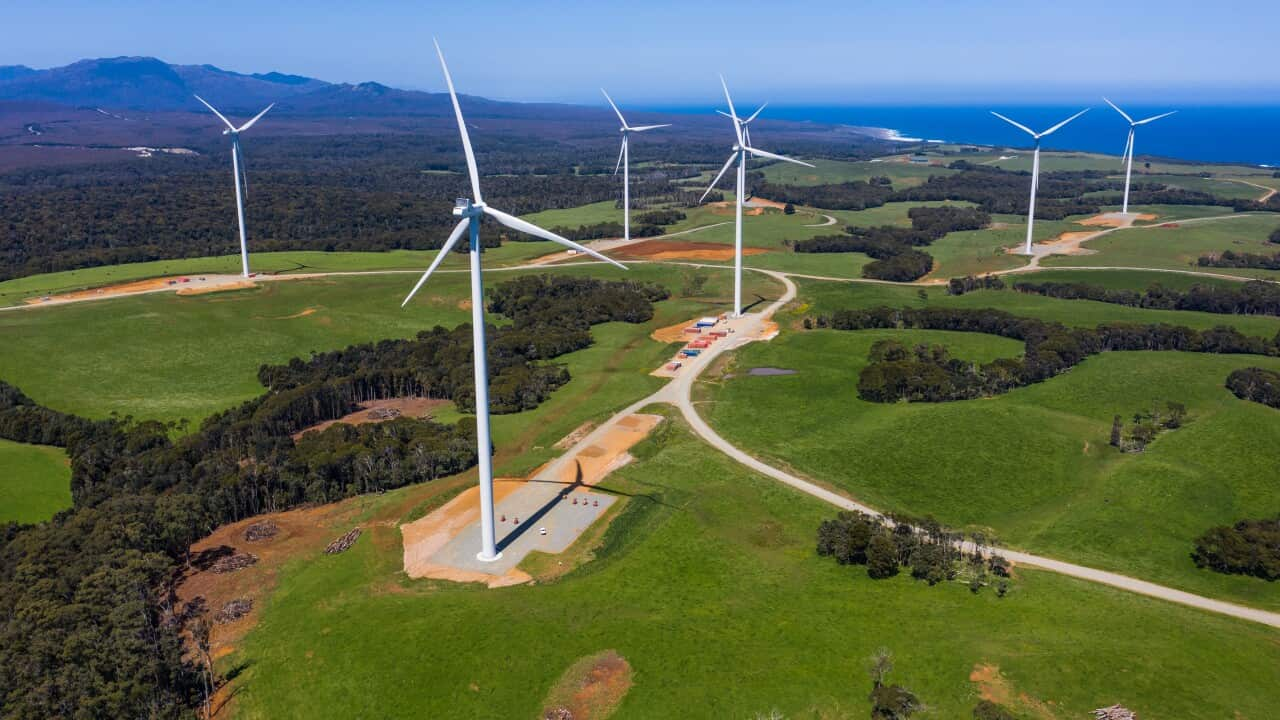Key Points
- Labor's climate bill has officially passed the Senate.
- Here's what this means for Australia, and what will change.
The Labor Party's climate bill officially passed parliament, with new targets - including a 43 per cent emissions reduction by 2030 and net-zero by 2050 - soon to be enshrined in law.
It will also require the minister for climate change to report annually to parliament on the progress of meeting these targets.
The legislation was opposed by the Coalition, but supported by key crossbench members.
While the Greens also supported the bill, they said its current targets do not go far enough.
So what happens now, what will change, and what does this mean for Australia?
Why was this bill a priority, and what happens next?
Before winning the federal election, where climate change was a key issue, Labor pledged it would enshrine action on climate change.
In December 2021, it unveiled its 'Powering Australia' plan, saying its goal of reducing emissions by 43 per cent by 2030 would keep Australia on track to hit net-zero by 2050.
On Thursday, Energy Minister Chris Bowen said Australia has had "too many bad days on climate change".
"Today is a good day for our parliament and our country, and we're going to need many more of them. Today is one step, but it is a big step," he said.
"To give this country a sensible climate change policy, to give this country a climate change policy that sends the message to the world that we are open for business, for renewable energy, for transmission and for storage.
"This is a good day for our climate."
Did the Greens support the bill?
In 2019, Labor took a slightly higher goal of 45 per cent to that year's election, which the party lost.
The government has previously said its current target of 43 per cent was reached by determining policy settings required to secure a pathway to reaching net zero by 2050, rather than starting with an intended target.
On Thursday, Greens senator Larissa Waters described this emissions reduction target as "flimsy", and moved for it to be increased to 75 per cent by 2030.
This is the target the Greens took to May's federal election.
"The bill that we have before us today was designed not by climate scientists, but by political scientists, and the flimsy 43 per cent emissions reduction target that this bill will enshrine is not enough," she said.
"It's not based on science, and it puts us nowhere near the 1.5C aspiration of the Paris climate agreement ... it puts us closer to 2C which we know is an incredibly risky climate situation where we may see catastrophic effects that set off a chain reaction that is not stoppable.
"I don't know about anyone else in this chamber but I can't actually bear the thought of that; we must do everything we can to stop that from happening."
Independent senator David Pocock also voted for the legislation, but agreed the target was not high enough.
He also expressed frustration at ongoing disputes.
"It seems like a pretty sad day in Australia where in 2022 we're hearing arguments about climate science," he said.
He was also asked to withdraw an "unparliamentary term" after describing the disagreements as "bulls**t".
Should the emissions reduction targets be higher?
Dr Cassandra Star is Associate Professor of Public Policy at South Australia's Flinders University and director of the university's Climate and Sustainability Policy Resarch Group.
She described the legislation as a "step in the right direction", but still insufficient when it comes to meeting international responsibilities under the Paris agreement.
"We would need to be looking in the vicinity of the teal independents or the Greens, and they differ a little bit but they're saying between 65 and 75 per cent reduction by 2030, and a bringing forward of that date for net-zero," she said.
Dr Star says Australia is already feeling significant impacts of climate change.
"We're not just talking about increases in temperature or sea level rise, but there's also increased variability there in the extremes of climate that we might expect," she says.
"We can see those impacts in a range of things that we've seen happening to us in the last couple of years ... look at the floods in Lismore, for example, or the Black Summer fires, there's an influence of climate extremes in those, and that sort of physical impact."
How does the legislation compare to other countries' climate policies?
While numerous countries have implemented climate policies and emissions targets, they are all slightly different.
The United Kingdom committed to reducing emissions by 78 per cent by 2035 compared to its 1990 levels.
Japan intends to reduce emissions 46 per cent by 2030 compared to 2013 levels, Canada 40 per cent by 2030 compared to 2005 levels and New Zealand 50 per cent by 2030 compared with 2005 levels.
"(Australia's policy) is actually relatively different to what a lot of countries overseas have done," Dr Star says.
"The United Kingdom and Ireland have used a framework piece of legislation like this, but in the UK that was in conjunction with budget reporting ... and this was relatively successful, but it also had bipartisan support, which as we know has been a challenge in the Australian political context."
What is Australia's current energy situation, and how might this change?
Through Labor's policy, the government is seeking to secure Australia's energy transition from its reliance on fossil fuels.
According to the Australian Energy Market Operator (AEMO), in 2022, 66.6 per cent of Australia's electricity is generated by thermal generation (comprised of black coal, brown coal, natural gas and liquid fuel).
AEMO says renewables including wind, rooftop solar, grid-scale solar, hydro and biomass make up 33.31 per cent of Australia's energy market, with the remaining 0.10 per cent from battery storage.
In Labor's Powering Australia plan - which is separate to the legislation - the party said it would invest $20 billion towards upgrading the electricity grid so it can handle more renewable energy, and install hundreds of community batteries across the country that will be charged by rooftop solar and provide shared energy storage.
Dr Star says it is difficult to predict the impacts of the legislation until a full plan is released.
"It's hard to say, because it is a framework piece of legislation, rather than a detailed plan," she said.
"The legislation really is a statement of direction ... they haven't necessarily said exactly how they are going to drive that (reduction) ... but it creates a very clear signal to the business community, to our international partners, and to our local domestic community that the government is serious about this target."













